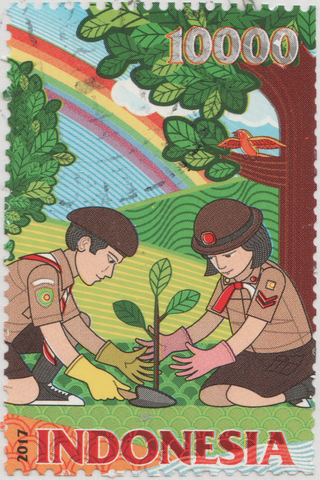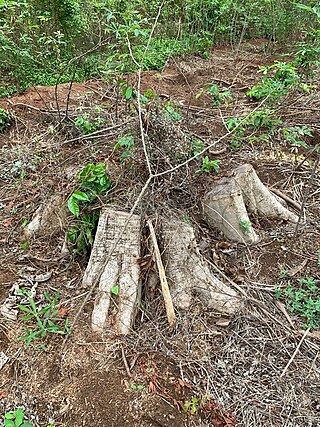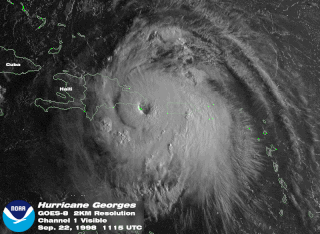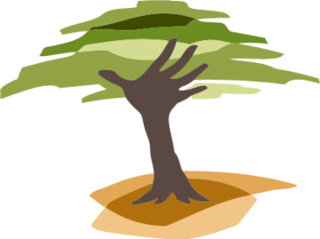

There have been great challenges to the environment and biodiversity of Haiti. Deforestation in Haiti has left approximately 30% percent of forest cover at present.


There have been great challenges to the environment and biodiversity of Haiti. Deforestation in Haiti has left approximately 30% percent of forest cover at present.

The island of Hispaniola is home to more than 6,000 plants, of which 35% are endemic; and 220 species of birds. None of the birds are endemic to Haiti, but La Selle thrush is nearly so. The country's originally high biodiversity is due to its mountainous topography and fluctuating elevations in which each elevation harbors different microclimates. The country's varied scenery include lush green cloud forests (in some of the mountain ranges and the protected areas), high mountain peaks, arid desert, mangrove forest, and palm tree-lined beaches. [1] Since arrival of aboriginal man, the biodiversity of Haiti has been significantly diminished due to human exploitation. For example, the Caribbean monk seal, the only pinniped ever to occur in the Caribbean, is now extinct. [2]
In addition to soil erosion, deforestation in Haiti has caused periodic flooding, as seen on 17 September 2004. Tropical storm Jeanne skimmed the north coast of Haiti, leaving 3,006 people dead in flooding and mudslides, mostly in the city of Gonaïves. [3] Earlier that year in May, floods killed over 3,000 people on Haiti's southern border with the Dominican Republic. [4]
Haiti was again pummeled by tropical storms in late August and early September 2008. The storms—Tropical Storm Fay, Hurricanes Gustav, Hanna and Ike—all produced heavy winds and rain in Haiti. Due to weak soil conditions throughout Haiti, the country's mountainous terrain, and the devastating coincidence of four storms within less than four weeks, valley and lowland areas throughout the country experienced massive flooding. Casualties proved difficult to count because the storm diminished human capacity and physical resources for such record keeping. Bodies continued to surface as the flood waters receded. A 10 September 2008 source listed 331 dead and 800,000 in need of humanitarian aid. [5] The grim state of affairs produced by these storms was all the more life-threatening due to already high food and fuel prices that had caused a food crisis and political unrest in April 2008. [6]
As was the case in 2004, the coastal city of Gonaïves was hit especially hard by the 2008 storms.
There were also major problems in 1999 with hurricanes, leaving 9,398 dead, 10,000 injured and at least 5,000 missing.
In 1925, Haiti was lush, with 60% of its original forest covering the lands and mountainous regions. Since then, recent in-depth study of satellite imagery has erroneously concluded an estimate of <1% primary forest cover. [7] Erosion has been severe in the mountainous areas. Most Haitian logging is done for agriculture and to produce charcoal, the country's chief source of fuel.
In the 19th century, arable land in the size of 15 hectares was distributed to farmers. It was inherited and divided by their children. In 1971, the average farm size was less than 1.5 hectares. To survive, the landowners had to overuse the land. It became infertile within a few years. The farmers moved to clear steeper hillsides and finally become unemployed. Eventually the shortage of arable land and rising rural poverty pushed peasants from hillside subsistence farms to search for work in Port-au-Prince, where the concentration of desperate people in slums contributed to the country's tragic history of civil strife. [8]
Despite the large environmental crises, Haiti retains a very high amount of biodiversity in proportion to its small size.
Haiti faces key challenges in the water supply and sanitation sector. Notably, access to public services is very low, their quality is inadequate and public institutions remain very weak despite foreign aid and the government's declared intent to strengthen the sector's institutions. Foreign and Haitian NGOs play an important role in the sector, especially in rural and urban slum areas.

Deforestation or forest clearance is the removal and destruction of a forest or stand of trees from land that is then converted to non-forest use. Deforestation can involve conversion of forest land to farms, ranches, or urban use. The most concentrated deforestation occurs in tropical rainforests. About 31% of Earth's land surface is covered by forests at present. This is one-third less than the forest cover before the expansion of agriculture, with half of that loss occurring in the last century. Between 15 million to 18 million hectares of forest, an area the size of Bangladesh, are destroyed every year. On average 2,400 trees are cut down each minute.

The Republic of Haiti comprises the western three-eighths of the island of Hispaniola, west of the Dominican Republic. Haiti is positioned east of the neighboring island of Cuba, between the Caribbean Sea and the North Atlantic Ocean.

Honduras is a country in Central America. Honduras borders the Caribbean Sea and the North Pacific Ocean. Guatemala lies to the west, Nicaragua south east and El Salvador to the south west. Honduras is the second largest Central American republic, with a total area of 112,890 square kilometres (43,590 sq mi).

Hurricane Jeanne was a Category 3 hurricane that struck the Caribbean and the Eastern United States in September 2004. It was the deadliest hurricane in the Atlantic basin since Mitch in 1998. It was the tenth named storm, the seventh hurricane, and the fifth major hurricane of the season, as well as the third hurricane and fourth named storm of the season to make landfall in Florida. After wreaking havoc on Hispaniola, Jeanne struggled to reorganize, eventually strengthening and performing a complete loop over the open Atlantic. It headed westwards, strengthening into a Category 3 hurricane and passing over the islands of Great Abaco and Grand Bahama in the Bahamas on September 25. Jeanne made landfall later in the day in Florida just two miles from where Hurricane Frances had struck a mere three weeks earlier.

Hurricane Gordon was an erratic, long-lived, and catastrophic late-season hurricane of the 1994 Atlantic hurricane season. The twelfth and final tropical cyclone of the season, Gordon formed as a tropical depression in the southwestern Caribbean on November 8. Without strengthening, the depression made landfall on Nicaragua. Later on November 10, the system began to strengthen as it tracked further from land, and it quickly strengthened into Tropical Storm Gordon, the seventh named storm that season. Gordon also made landfalls in Jamaica and Cuba while a minimal tropical storm. It entered the southwestern Atlantic while resembling a subtropical cyclone. By the time it entered the Gulf of Mexico, the storm was fully tropical again. Tropical Storm Gordon later crossed the Florida Keys, and turning to the northeast it made landfall in Fort Myers, Florida. Gordon strengthened after it re-entered the Atlantic Ocean, becoming a hurricane on November 17. It briefly threatened North Carolina while turning to the northwest, although it turned to the south and weakened. Gordon deteriorated into a tropical depression and struck Florida again at that intensity on November 20. It turned to the north and dissipated the next day over South Carolina.

Tropical Storm Alpha was the 23rd tropical or subtropical storm of the extremely active 2005 Atlantic hurricane season. It developed from Tropical Depression Twenty-Five in the eastern Caribbean Sea on October 22, 2005. As the 21 pre-designated storm names had been exhausted, it was given the first name on the auxiliary list, which utilized the letters of the Greek alphabet. This was the first hurricane season ever to trigger this naming protocol, and the only one until the 2020 season.

Environmental issues in Haiti include a historical deforestation problem, overpopulation, a lack of sanitation, natural disasters, and food insecurity. The major reasons for these environmental issues are corruption, human exploitation, and the embezzlement of taxpayers' funds for personal gains. In addition, there is not sufficient protection or management of the country's natural resources. Other environmental issues, such as decreases in precipitation and more severe natural disasters, will likely arise in Haiti as a result of climate change. Experts agree that Haiti needs to adopt new policies to address both the issues that already exist and to prepare for the effects of climate change.

Environmental issues in Indonesia are associated with the country's high population density and rapid industrialisation, and they are often given a lower priority due to high poverty levels, and an under-resourced governance.
The Caribbean bioregion is a biogeographic region that includes the islands of the Caribbean Sea and nearby Atlantic islands, which share a fauna, flora and mycobiota distinct from surrounding bioregions.

Hurricane Noel was a deadly tropical cyclone that carved a path of destruction across the Atlantic Ocean from the Caribbean Sea to Newfoundland in late October 2007. The sixteenth tropical depression, fourteenth named storm, and the sixth hurricane of the 2007 Atlantic hurricane season, Noel formed on October 27 from the interaction between a tropical wave and an upper-level low in the north-central Caribbean. It strengthened to winds of 60 mph (97 km/h) before making landfall on western Haiti and the north coast of eastern Cuba. Noel turned northward, and on November 1, it attained hurricane status. The hurricane accelerated northeastward after crossing the Bahamas, and on November 2, it transitioned into an extratropical cyclone.

Deforestation in Haiti is a severe environmental problem. Haitians burn wood charcoal for 60% of their domestic energy production.

Deforestation in Nigeria refers to the extensive and rapid clearing of forests within the borders of Nigeria. This environmental issue has significant impacts on both local and global scales.

Hurricane Hanna was a moderately powerful but deadly tropical cyclone that caused extensive damage across the Western Atlantic, mostly in the Turks and Caicos Islands and the East Coast of the United States. The eighth named storm and fourth hurricane of the 2008 Atlantic hurricane season. It formed east-northeast of the northern Leeward Islands on August 28. Initially, the storm struggled to intensify due to moderate wind shear as it moved westwards towards the Bahamas. By August 31, Hanna had drifted southwards and began intensifying while over the Bahamas; it attained its peak intensity as a Category 1 hurricane while over the Turks and Caicos Islands. Due to the outflow of the nearby Hurricane Gustav, Hanna weakened back into a tropical storm the next day as it began to drift northwestwards towards the Southeastern United States. The storm struck Myrtle Beach, South Carolina, before moving up the Eastern Seaboard to become an extratropical cyclone as it moved by New England into Atlantic Canada early on September 7. The system raced across the North Atlantic, sweeping west of Great Britain on September 10 before turning north and becoming absorbed by a stronger extratropical cyclone between Iceland and Greenland late on September 12.

The effects of Hurricane Georges in Haiti included about $200 million in damages and 209 fatalities. Georges impacted the country at Category 1 strength.

The wildlife of Haiti is important to the country because of its biodiversity. According to the World Conservation Monitoring Centre, Haiti is considered to be "one of the most biologically significant countries of the West Indies". With an estimated 5,600 plant species on the island of Hispaniola, some of which only occur in Haiti, 36% are considered as endemic to the island. A mountainous area country, it is situated in the western three-eighths of Hispaniola and shares a border with the Dominican Republic. There are nine life zones, from low desert to high cloud forests, as well as four mountain ranges, and hundreds of rivers and streams and the coral reefs in the seas that surround the islands. Issues of environmental damage, expanding population, deforesting and erosion are of concern; less than 2% of the original forest remains on account of deforestation. This degradation is traced from the 17th century to 19th century starting with the French colonization of the Haiti and population explosion during the 20th century and for the purpose of forestry and sugar-related industries, degraded the forests. and the environment.

Eden Reforestation Projects (Eden) is a nonprofit NGO that works in developing countries to rebuild natural landscapes destroyed by deforestation. Eden works directly with communities experiencing extreme poverty resulting from the deforestation and destruction of the land that sustains them. The organization employs thousands of local community members and provides them with the education and tools necessary to plant, grow, and protect to maturity, millions of trees each year. Eden currently plants approximately 15 million trees a month, and in 2020 reached over 423 million trees planted of which over 225 million are mangrove trees.

In early July 2005, Hurricane Dennis brushed the southern coast of Haiti and produced deadly flash flooding across the nation. Forming from a tropical depression on July 4, Dennis began impacting Haiti two days later with heavy rains. Civil authorities and international agencies acted quickly to protect lives, ordering evacuations—approximately 1,000 people complied—and prepositioning emergency supplies. Over the subsequent two days, the hurricane's outer bands continued to impact the nation before effects abated. Widespread flash floods and landslides caused substantial damage, with areas along the Tiburon Peninsula taking the brunt of the impact. A bridge collapse near Grand-Goâve left 15 people dead or missing.

Due to its geographical and natural diversity, Indonesia is one of the countries most susceptible to the impacts of climate change. This is supported by the fact that Jakarta has been listed as the world's most vulnerable city, regarding climate change. It is also a major contributor as of the countries that has contributed most to greenhouse gas emissions due to its high rate of deforestation and reliance on coal power.

Hispaniola is an island in the Caribbean, with the second largest size throughout all of the Caribbean. Throughout the centuries, since reliable records began, hundreds of hurricanes and tropical cyclones have affected Haiti and the Dominican Republic, the two countries that share the island. The most recent tropical cyclone to affect Hispaniola was Hurricane Franklin in August 2023.

Climate change in Fiji is an exceptionally pressing issue for the country - as an island nation, Fiji is particularly vulnerable to rising sea levels, coastal erosion and extreme weather. These changes, along with temperature rise, will displace Fijian communities and will prove disruptive to the national economy - tourism, agriculture and fisheries, the largest contributors to the nation's GDP, will be severely impacted by climate change causing increases in poverty and food insecurity. As a party to both the Kyoto Protocol and the Paris Climate Agreement, Fiji hopes to achieve net-zero emissions by 2050 which, along with national policies, will help to mitigate the impacts of climate change.